
Parc de la Mar
Until the 1960s the sea reached up to the city walls, providing the perfect reflection for the cathedral. When the building of a new road changed all that, an artificial lake was constructed to reproduce the effect.

© seemallorca.com

© seemallorca.com

© seemallorca.com

© seemallorca.com

© seemallorca.com

© seemalloroca.com
All-encompassing walk taking in the hidden nooks & crannies
Starting in front of the cathedral, this walk takes you past the main sites of Palma de Mallorca and includes modern art, Arab baths, ancient cloisters, hot chocolate in an 18th century cafe, a walk among the flower sellers, a langosta in Bar Bosch, ancient shipyards and a king's garden.
Start at the Parc del Mar, built in the mid-1980s, a home to a collection of modern sculptures, as well as a gigantic mural by Joan Miró. From the park you get an overall view of the Casc Antic (the ancient centre) and the 17th and 18th century walls which enclose the city, more or less following earlier ones dating back to Arab times.
Enter through the walls by way of the Porta de la Portella, which is near the right-hand edge of the lake. On the left is the late 17th century Cala Torre, today the Collegi d'Arquiteetes. Next to it is the baroque doorway to the Posada de Cartoixa. At the first corner are the 17th century façade and balcony of Can Formiguera, home of the legendary Comte Mal or 'Bad Count'. Turn right, follow carrer Serra around to the left until it passes under a small bridge. The Banys Arabs (Arab Baths) are found at No 7. They date back to the times of the Walis (the Arab governors), during the 9th and 10th centuries.
At the next corner take a hard right and follow this short street till it enters the patio of the Convent de Santa Clara. Founded by King Jaume X in 1256, the accompanying church was built in the 1600s. Turn back onto carrer de Santa Clara, continue briefly on carrer de Pont i Vich, and turn right at carrer de Montesió. At No 6 is Can Malonda, also dating from the 17th century. In front of the baroque façade of the Church of Montesió is the 18th century house of the Baró (Baron) de Pinopar.
Enter the carrer de la Criança beside the house and follow it to the end before turning left on carrer del Sol. The city's most important Renaissance façade, that of the Casa del Marquas de Palmer, is at No 7. Casa Juliá, at No 3, has an interesting example of arte mudéjar on the ceiling of the entrance.
Turn right onto carrer de Pare Nadal and then right again into the Plaça de Sant Francesc. Immediately to your right is the outstanding patio of Can Moragues, dating from the 18th century. On the opposite side of the square, to the right of the church, is the entry to the Cloister of the Convent of Sant Francesc. Built in the 14th century, it embodies architectural elements added through the 16th century. The church, a Gothic structure with a baroque façade, may be entered from within the cloister. Near the church's main doorway is a statue of Mallorcan missionary Fray Junípero Serra, founder of California. Carrer de Can Troncoso skirts the church until you turn onto carrer de Zavellá. At No 15 is the Gothic Can Callar del Llorer. At No 4 Can Vivot has the city's most important patio, in the baroque style, dating from the 18th century. It is still home to the Count and Countess of Savellá. Opposite, at No 13, look into the restored 17th-century baroque entrance of the earlier Gothic Can Savellá.
One block to the left, on carrer de Sanc, is the oldest cafe in the city, Can Joan de S'Aigua. Today specialising in Mallorcan hot chocolate, almond ice cream and Mallorcan pastries, it opened in the 18th century selling drinks chilled with snow brought down from the mountains.
Return to carrer Fiol, turn left and continue past the church to Plaça de Santa Eulália. The Gothic church is open in the mornings. Leaving the square by way of Carrer de'n Morey, you will find Can Oleza at No. 9, with one of the finest examples of Mallorcan-style patios of the 18th century. The façade is 16th century Renaissance. At the next corner turn right onto carrer de Pere Nolasco, which runs along the front of the Gardens of the Bishop's Palace, then turn right onto carrer de Zanglada. The patio of the house of Mallorcan poet Guillem Colom, at No 4, contains interesting ironwork around the well. The patio itself is late 18th century baroque.
Where the street ends at Carrer de l'Almudaina, look right. The Arc de l'Almudaina is generally thought to be Arab, but some experts believe it dates further back, to Roman times. Continuing left along the same street, both the Gothic 13th century Can Bordils (No 9) and its 17th century next-door neighbour, Can Oms (at No 7) are interesting public buildings that may be entered during office hours. Can Oleo is one of the best medieval houses in the city and may soon be opened to the public.
Turning right onto carrer Palau Reial, you will pass the towered neo-Gothic headquarters of the century-old Consell Insular de Mallorca (the island government) and enter into the Plaça Cort, which has been the hub of city life since the 13th century. The present Ajuntament (city hall) was built in the 17th century and is in the baroque style. You may enter the street level hallway, where you will see the elegant imperial staircase and a pair of ceremonial Mallorcan giants of paper-maché.
From the square, continue along Carrer de'n Colon, on which are two of the city's best examples of Modernist architecture. Grabbing most of the attention is the colourfully tiled Can Rei (corner of carrer Bolseria) with its grotesque, frowning window box. Next door stands the eclectic work of local architect Gaspar Bennassar, Almacenes Aguila. Both buildings date from the early years of the 20th century.
The archways lead into the Plaça Major. Built at the beginning of the 19th century on the site of the Inquisition building, it was renovated in 1951. On Monday, Friday and Saturday mornings, it is the site of a crafts market. Straight through the square on carrer de Sant Miquel you will find an early 20th-century building, the Headquarters of the March Foundation, which is open as a cultural centre and art gallery. Further along on the same side is the Church of Sant Miquel (No 21) on the site of a mosque. On the other side, at No 32, are the Church and Cloister of Sant Antoniet. Built in the 18th century in late baroque style, the cloister is often the site of exhibitions ranging from displays of Japanese Bonsai trees to anti-nuclear protest material.
Continuing along Carrer Sant Miquel, pass the Church of Santa Catalina, turn right and enter Plaça d'Espanya. In the centre is a monument to 'Jaume 1, Conqueridor de Mallorca'. Other notable structures are the eclectic buildings of the Sóller train station on the far side of the Avinguda Joan March Ordinas and the two corner buildings, which also display eclectic Modernist touches. The cafe 1916 is recommended for a light lunch and if you're on time, Foto Laser is a good place to leave your films for quick processing.
Descend Carrer d'es Olmos till it intersects La Rambla. This tree-lined avenue was, until the 17th century, the watercourse through Palma. Walking down among the myriad flower stalls you may catch sight, on the right-hand side, of a beautifully restored rosecoloured façade at No 9. The brace of Roman centurions at the end of the promenade date from the time of Franco. Turning right, you are confronted by the 19th century Classicist facade of the Teatre Principal, which hosts plays and concerts from April through to the end of June.
Immediately to the left, on Carrer Unio, is the Centro Cultural de la Caixa de Barcelona, housed in the recently restored Gran Hotel, a magnificent art nouveau structure built in 1902 by Catalan architect Doménech i Montaner. On the opposite side of the road is the Palau de Justicia, in Can Berga, a seignorial house dating from the 18th century. Next door sit the twin Modernist buildings of Casa Casasayas and Pensión Menorquina, built in 1910 and 1911 respectively. Further along on the right-hand side is the 18th century Círculo de Bellas Artes, which often houses exhibitions.
Stop for coffee at the Bar Bosch, in the Plaça Juan Carles 1. It also serves its own variety of sandwiches in rolls called langostas (lobsters). From the terrace in front of the cafe you can see the arched loggia and restored details of the façade of the 18th century palace Casal Solleric. The building, which is owned by City Hall, holds regular art exhibitions. The entrance can be found at Carrer Sant Gaiet 10.
Follow the Passeig des Born, the wide promenade leading in the direction of the port. Originally a long finger-like inlet leading from the sea, it was filled in the 17th century, to be used as a place in which to hold popular festivals, including jousting. At the corner of carrer Sant Feliu, turn right. Passing the 18th-century seignorial mansion of Can Quint (above Restaurante Antonios) you soon encounter the tiny Oratori de Sant Feliu. The small chapel itself is 13th century Gothic, while the façade, on carrer Gaietá, is Renaissance. A few metres further along is a design school housed in Ses Carasses. The inscription above the ornate doorway makes reference to the builder, who was an Italian merchant of the 17th century.
Backing up a few paces, turn left into carrer Montenegro. On the right is the baroque façade of Can Montenegro, which belonged to one of the most powerful families in the city. The large plaque on the front refers to a member of the family, who was Grand Master of the Order of Malta. Turning right into Carrer Glória you arrive, at the end, between two interesting houses. On the left is the enormous Cal Capitá Flexes built by a 'corsair' who became incredibly rich during the 17th century. In front, and on the opposite side of Glória, is the patio opening to Can Llull, a tasteful restoration of the 18th century house.
Going down the small hill you arrive at the chaotic Placa Drassanes (Plaza Atarazanas), which was the site of Mallorca's most important shipyard from the 13th to the beginning of the 19th century. In the centre is a statue of the famous Mallorcan sailor Jaume Ferrer. Leaving the square by carrer Consulat, you see above to the right Can Chacón and to the left the Consulat del Mar. The latter, built in the 17th century as a court concerned with maritime affairs, has been the seat of the provincial government the Govern Balear since 1983.
Continuing past the flags and cannons in front of the building, along Passeig, you come to the antique La Llotja, which was built to house the 'College of the Merchants' in the 15th century. It was built in the Gothic style by Guillem Sagrera. Today it is used by the provincial government and is open only when there is an exhibition on display.
On the right, beside the main road, is the prominent statue of the 13th century Mallorcan philosopher and scientist, Ramon Llull. The pedestal dedication is in Catalan, Arabic and Latin, recalling his contributions in all three languages. Crossing the Avinguda Antoni Maura, named after a Mallorcan politician of the early 1900s, you will find the S'Hort del Rei (the Garden of the King). Originally a garden associated with the Almudaina Palace above, it was converted for public use only a few years ago. It contains several modern sculptures as well as a bronze Mallorcan hondero (the early sling throwers).
At the upper end of the garden, near the egg-shaped sculpture by Joan Miró, are the stairs leading up to the Cathedral. The building on the left, as you climb, is the Palau March. It was built by Mallorcan financier Joan March in the 1940s, when he was reputed to be the third richest man in the world. On the ground level is the entrance to the March Library, the most important private library on the island. Directly in front, at the top of the stairs, is the 16th century house of L'Ardiacanat.
Turn right and enter the Plaça de l'Almoina. Before entering the Cathedral you will see, on the left, a Mannerist façade with interesting details from the 17th century.
The cloister and the museum of the Cathedral are entered by way of the Gothic Casa de l'Almoina, which was, in times gone by, a charity house. The Cathedral (Seu) was begun in the 14th century and finished in the 16th, except for the main facade, which was finally completed in neo-Gothic style in the 19th century. Several styles are present, including 20th century Modernist touches added by Antoni Gaudí between 1902 and 1914. Half of the 87 windows are cemented over. There are seven rose windows, the biggest of which has a diameter of 12.5m (41ft).
Across the square from the Cathedral is the Palau de l'Almudaina. This building has always been used as the centre of government for the island. It was the residence of the Muslim 'Walis' and later the kings of Mallorca. It is a typical Gothic palace of medieval date. Today the palace is part of the National Royal Patrimony and, since 1985, has been the official residence of the King of Spain when he is staying in Mallorca.
To end this walk, take the stairs down between the Cathedral and the Almudaina and turn right at the wall. On the right you will pass a large Gothic arch and a pond before you reach the next set of steps. The archway, the Arc de la Drassana Reial, dates back to Arab times, when it was the entrance to the royal shipyards beside the palace.
By following the steps for a few more metres you will return to the Parc del Mar.
Read about Palma's Sights & Attractions.

Until the 1960s the sea reached up to the city walls, providing the perfect reflection for the cathedral. When the building of a new road changed all that, an artificial lake was constructed to reproduce the effect.

This small museum of religious and historical antefacts is based in a wing of the former episcopal palace tucked behind the cathedral.
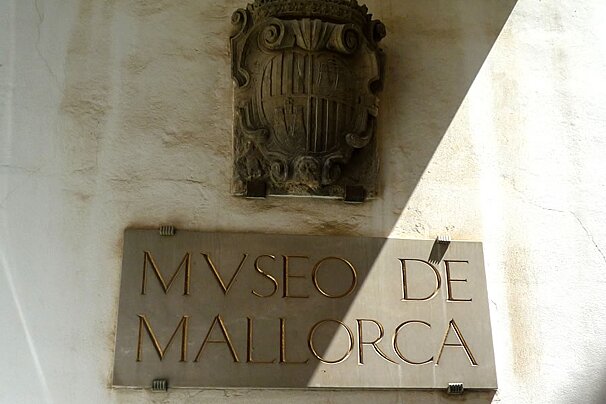
Billed as Mallorca's most important museum, this undoubtedly contains some fascinating exhibitsbut beware that it is difficult to get excited about bits of stone in glass cases if you do not understand the captions. The museum has recently been refurbished, so we are hoping it is now more tourist-friendly.
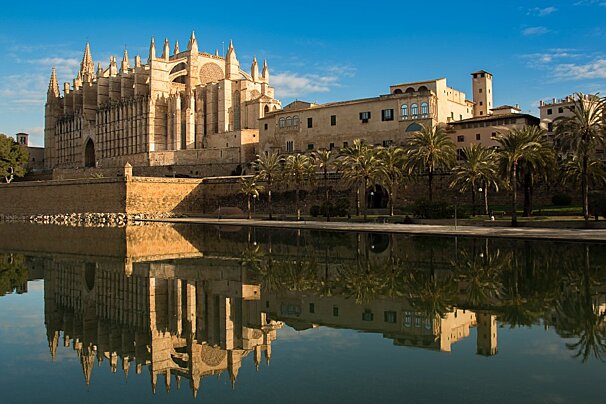
The glory of Palma - a magnificent Gothic cathedral whose sandstone walls and flying buttresses seem to rise out of the sea.

These 10th-century baths are virtually all that remain of the Arab city of Medina Mayurqa (now known as Palma).

A royal palace has stood on this site next to Palma's cathedral since the Muslim walis (governors) built their alcazar soon after the Arab conquest.
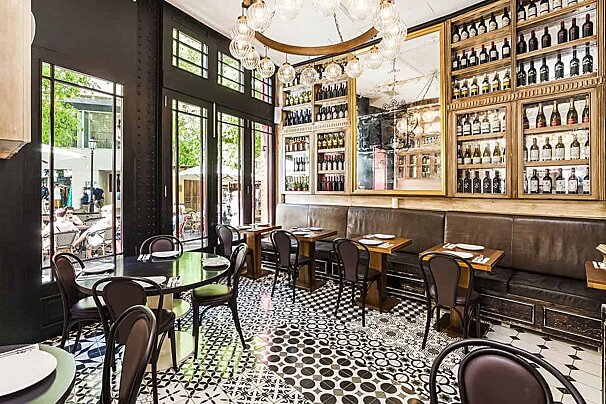
This restaurant is ideally located in Plaça de Cort in the city's old town. Enjoy a delicious meal and watch the world go by as you dine al fresco.

Cappuccino has a number of stylish brasseries in Mallorca, some of which are housed in the most beautiful historic buildings. This branch is located in the centre of Palma and has a large terrace.
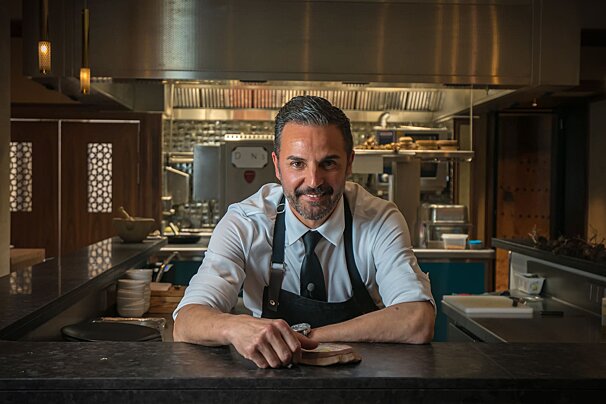
Situated in a historical area, a few metres from the cathedral of Palma de Mallorca and close to the sea, you will find Dins Santi Taura.

The ambience of this restaurant is casual and attracts a cosmopolitan crowd. The bar with its VIP area is the meeting point for travellers and locals who can listen to DJs playing. Small dishes are served in the bar and when the weather permits, food and drinks can be enjoyed on the patio.
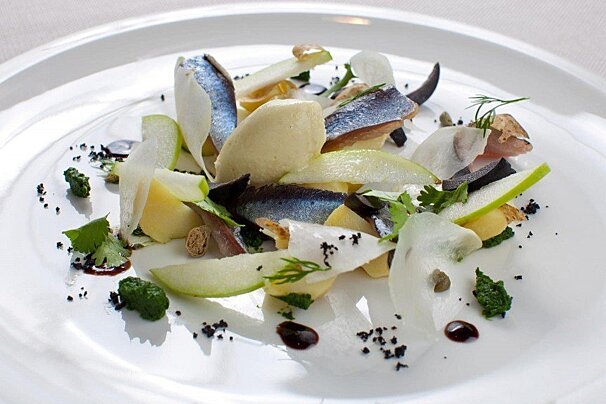
Chef Adrián Quetglas and his team create menus based on natural products, traditional recipes and avant-garde techniques of different but complementary cultures, always from the point of view of an author.
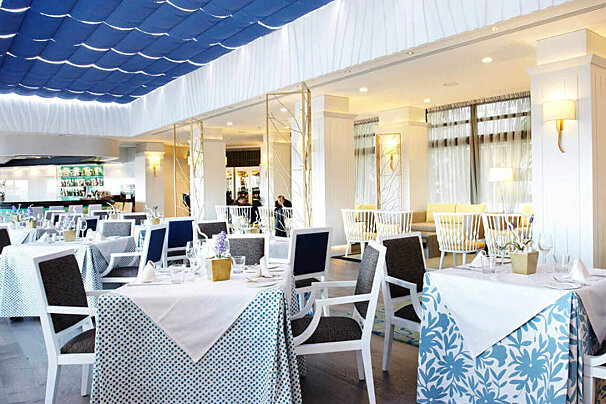
This charming restaurant has double height ceilings which highlight the bright and airy peaceful atmosphere and a wonderful terrace with spectacular views towards the marina.
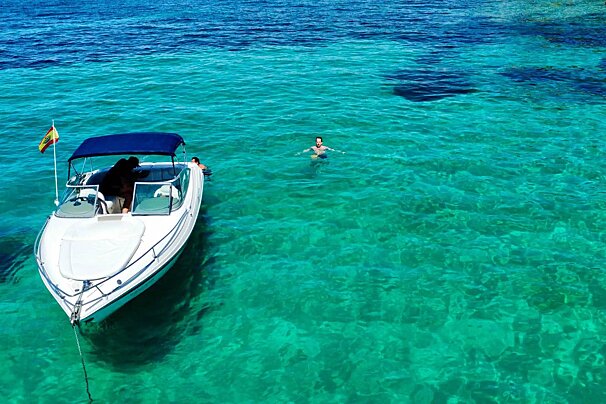
Enjoy four hours on a private motor boat in Palma Bay, perfect for small groups or those on a budget.
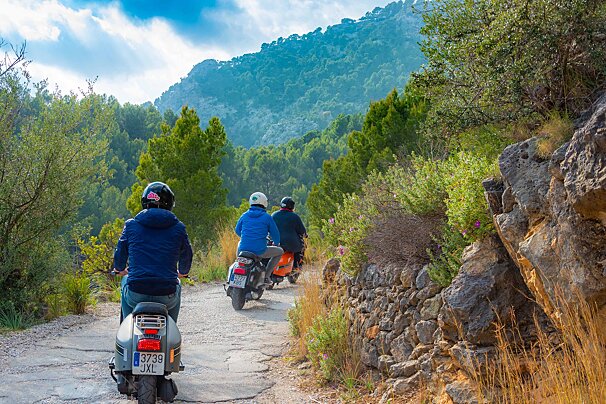
Picture-perfect views from your vintage scooter

Enjoy a fantastic day at sea and exploring secluded coves and beaches aboard a typical yacht from the Balearic Islands, "El Gordito".
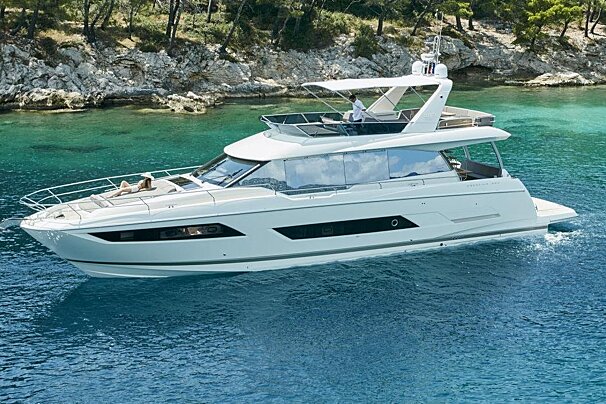
Take a trip onboard this luxury yacht along the coast of Mallorca or Ibiza to any destination of your choosing.
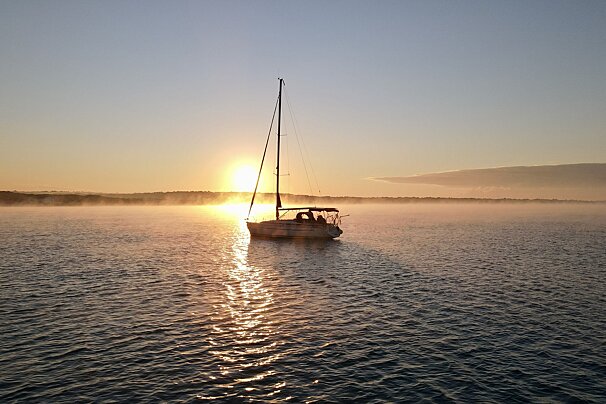
Relax aboard a luxury yacht as the sun sets over Mallorca’s coastline. Includes drinks, snacks, and snorkelling, with optional tapas and cava.
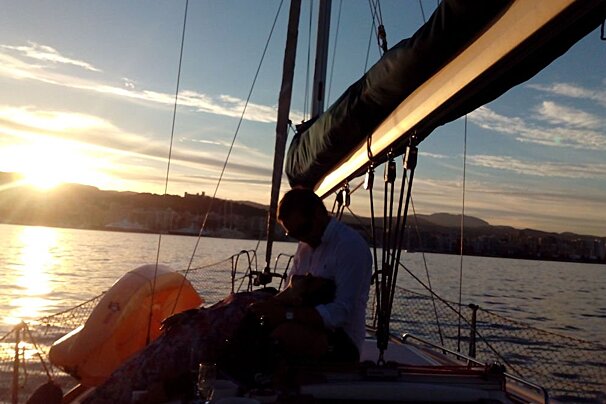
Take a wonderful boat trip and enjoy all the activities of swimming, snorkelling and stand-up paddle boarding as the sunsets over the beautiful island of Mallorca.

First mentioned in 1450, this site consists of various properties united in the 18th century to form a 132-acres estate. The current buildings, reformed in the 19th century, have been lovingly restored in 2013 to open as a luxury hotel that includes beautiful gardens.

Find peace and tranquillity in this chic, modern hotel just off the harbour promenade, with a bustling nightlife. With a friendly atmosphere that invites you to be happy.
Find out all about what is happening in Mallorca and how to make the most of your time here. The latest news, reviews of fun activities, fabulous beaches, current events and the trendiest restaurants, as well as interviews with leading locals, insider's guides and our top choices for things to do, see, and experience on the island.
See allLatest News & ReviewsThe island hosts all sorts of events, including agricultural fairs in the spring and autumn, live music and DJs in the summer, religious fiestas and international sporting events. Some of the most popular are the Mallorca 312 cycling race in April, the Copa del Rey sailing regatta in July and the Moors vs Christians mock battle in September.
See allUpcoming Events